Table of Contents Show
Tumblr is a force to be reckoned with; early 2010s Tumblr completely reimagined pop culture; aesthetics such as emo, punk, and alt proliferated across the website, spilling into mainstream culture. It’s also taught an entire generation social justice and educated them on topics school doesn’t teach them: how their identities are valid, the issues with representation in the media today, the history of minority struggles in the US and worldwide. Tumblr has contributed an immense amount of culture to the mainstream, yet it’s stayed relatively underground. It’s still regarded as a safe space for people with marginalized identities and gives them all the representation they’ll ever need in one site. However, after being in a “Tumblr bubble,” users often forget that the world isn’t as forgiving or loving as their favorite website.
Neglected Identities
Queer identities aren’t celebrated; they’re used for profit and clicks, as is the case with queerbaiting and with big corporation’s Pride marketing campaigns. Mainstream media has given queer characters a platform where they can be out. However, they are immediately killed off (AKA the “bury your gays” trope). If not that, they are stereotyped to oblivion or are never given a relationship because that would offend straight audiences and be unable to air in countries where homosexuality is banned. LGBTQ representation is at a push-and-pull. Media companies give audiences thirsting for representation enough to hang on for the ride while not giving them the actual representation they want and need.
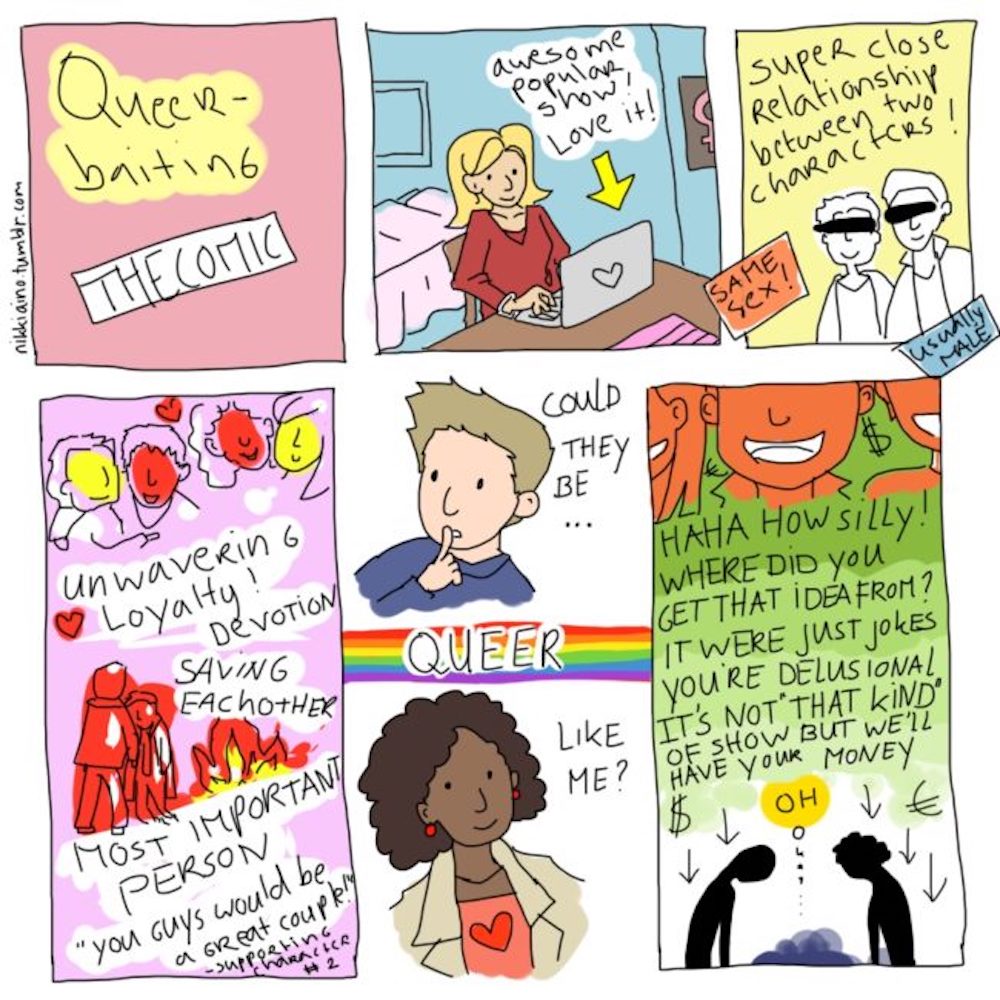
People of color’s identities are used as a form of appeasement in the face of criticism, casting actors of color in roles that weren’t written with their race in mind instead of creating stories for characters of color and having them be in their own original stories. The 2015 hashtag #OscarsSoWhite sent producers and directors scrambling to include more characters of color without a second thought about how best to represent them. Now, instead of having original stories with characters of color at the helm with depth and personality, they replace a white character or historical figure with an actor of color. The actor thus faces harsh backlash, and Hollywood hopes their minimal effort completely smooths over the racism in the entertainment industry.

All of this is to say: Tumblr has continuously provided people with marginalized identities a safe space to talk to others who are either empathetic or have the same identity as them. When these users consume mainstream media, they expect the same representation as what they’re used to online. But when mainstream media doesn’t listen and dangles representation in front of them like candy, they resort to their own means of representing these communities. Our first case study is “All or Nothing,” the web series that scammed Tumblr out of $5,899.
“All Or Nothing”
Sarah Z on YouTube covers this topic with a lot more depth in her video “Tumblr’s $6000 Scam: The Story of All or Nothing,” but here’s a quick overview.
A Tumblr user by the name of @discontentramblings publishes a post introducing the idea of a show containing a pansexual character and an asexual character who are roommates, titled “All or Nothing.” This post subsequently goes viral, and thousands of users gush about how amazing the representation would be and implore Netflix to produce it. They’d finally be able to see themselves in a mainstream media context instead of being confined to small safe spaces on the Internet. They’d be able to see themselves in shining lights and feel validated in their identity.
So, no wonder the post took off. Users kept adding more and more context, description, and plot to the original idea that it only drummed up more attention. This lead up to user @schrodingersnerd creating the infamous concept art for the show. They portray both characters as nonwhite, with the pansexual being awkward and shy and the asexual being outgoing and flirtatious, defying traditional stereotypes placed upon the sexualities.
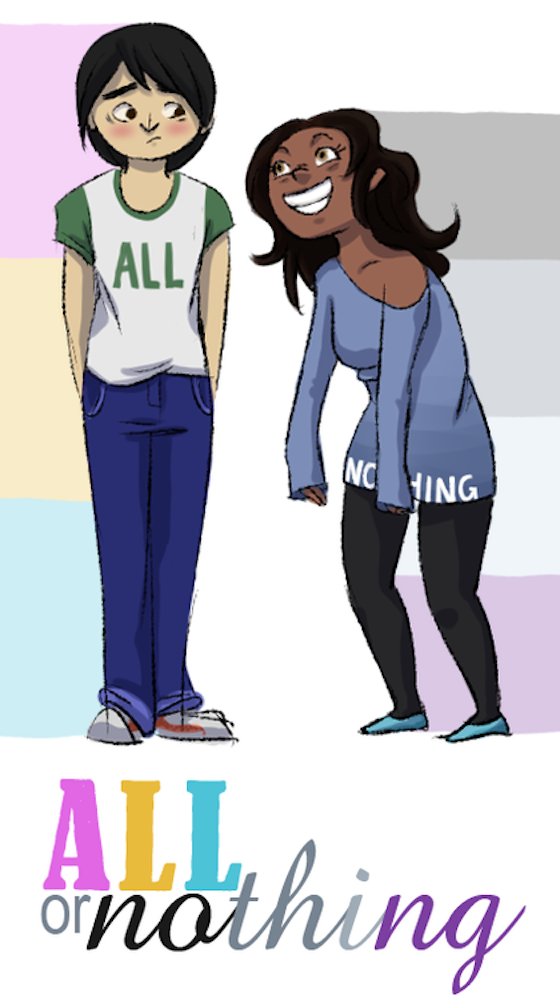
The idea skyrockets because of the addition of the concept art, and a group uses the art in their Indiegogo campaign that proceeds to raise $5,899 to make it a live-action web series. Fans are so over the moon about the possibility of an idea going from Tumblr and into mainstream spaces that they donate a portion of their paycheck to see themselves onscreen. This is the power of not only representation but the possibility of representation. Somebody advertised a diverse set of characters, and they exploited fans’ excitement for the fame and money they needed to grow without delivering a bit of what they advertised.
This is the case of “All or Nothing.” The group who set up the Indiegogo campaign set it as “flexible funding,” meaning that if the campaign goal is not reached or if the project doesn’t pan out, the creators of the fundraiser still get to keep all the money and don’t have to refund those who donated. This is what added to the scam-like nature of the whole debacle. A member of the group posted an apology, but that still doesn’t take away from the disappointment thousands of users felt when they realized their big project wasn’t going to pan out.
This example teaches us the sheer number of people — on Tumblr and abroad since this project reached outside of the site — who desperately want to see themselves or see more diversity in the media. The slight possibility that a big TV network like Netflix or Fox could pick this up and make it a reality fueled people’s passions even more and led them to donate to a fundraiser that had barely any content in it at all.
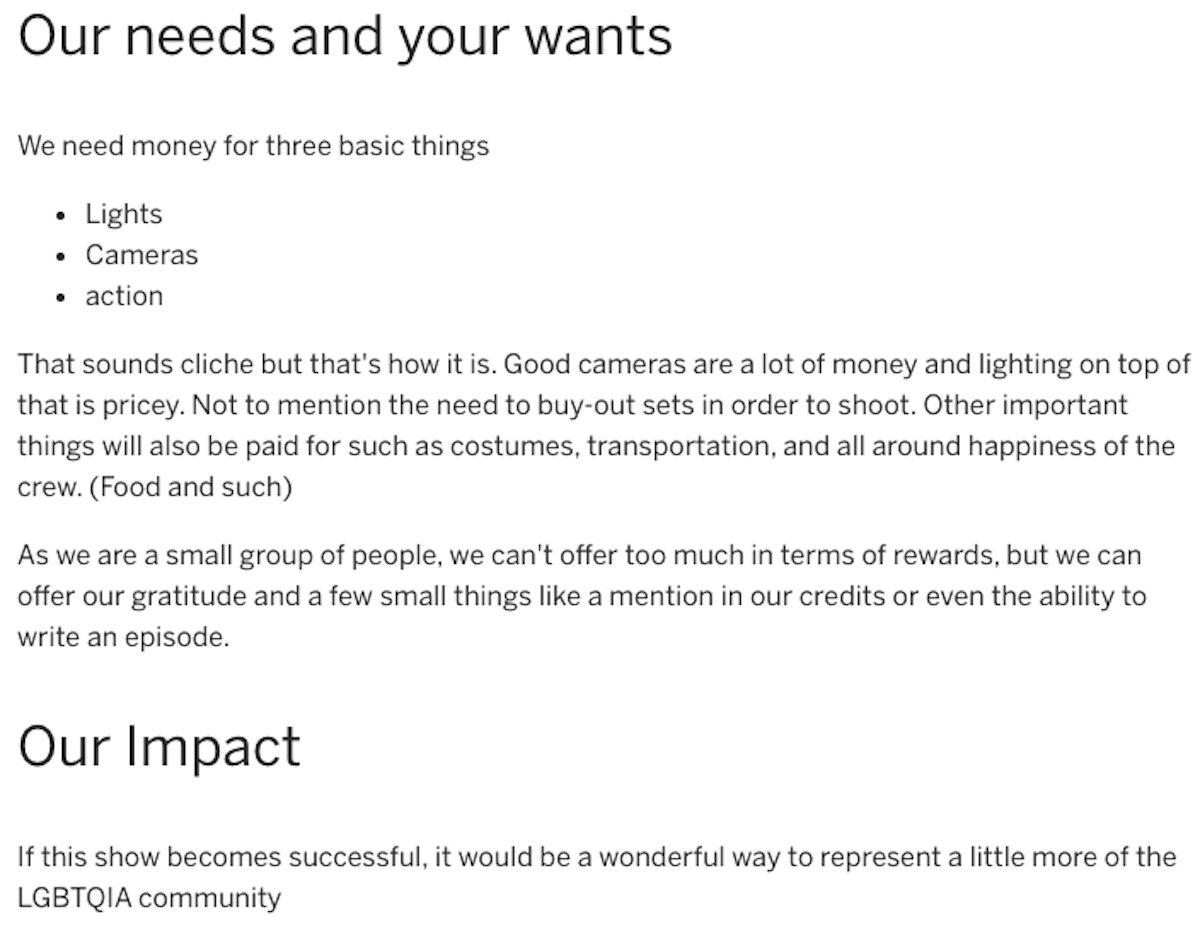
That’s another unaddressed issue: how little it takes to get people riled up about the possibility of a representational show. There was nothing to go off of in this show: no personalities for the characters, no plot, no setting, no nothing. The Indiegogo campaign, while raising almost $6,000, had a goal of $600, which was supposed to be used for the things mentioned in the image above. It doesn’t take an A-list Hollywood star to know that $600 can’t buy nearly anything on the list. Some of the cheapest cameras zap up to half the budget, not to mention paying the actors on the show. With such a vague description of their budget, we can’t possibly know what else they planned to use it for, and the show would at most look like a badly edited YouTube video—a far cry from the professional nature most people hoped they would see.
With such little information and a horrible budget breakdown, anybody would skip past it and claim it a scam. But people are blinded by starry eyes with the mere idea of having a show like this go viral and become famous. It would validate their identities and expose a mainstream audience to queer culture and new sexualities, making them commonly accepted rather than just part of a niche community on Tumblr. “All or Nothing” represents the biggest example of people ignoring all logic in favor of a potential series or movie, which can be seen as “cringe” or stupid. Still, it showcases the lengths people will go to see the representation they see on a daily basis on Tumblr. People want to see themselves in pop culture, and people use this as a possibility for profit and fame.
Queerbaiting
A more insidious way of scamming queer viewers and allies out of their money and time is queerbaiting, where a show drops hints of a character or characters being queer but never confirms it or acts upon it. Instead, they use the characters’ not-yet-specified identity as bait, dangling in front of representation-starved viewers who hang onto the show in case that character finally does come out or their two favorite same-sex characters get into a relationship. Then, to add salt to the wound, creators and actors oftentimes make fans look crazy or tell them they’re reading too much into the show to get them off their trail while still adding homoerotic subtext to keep them coming back for each episode.
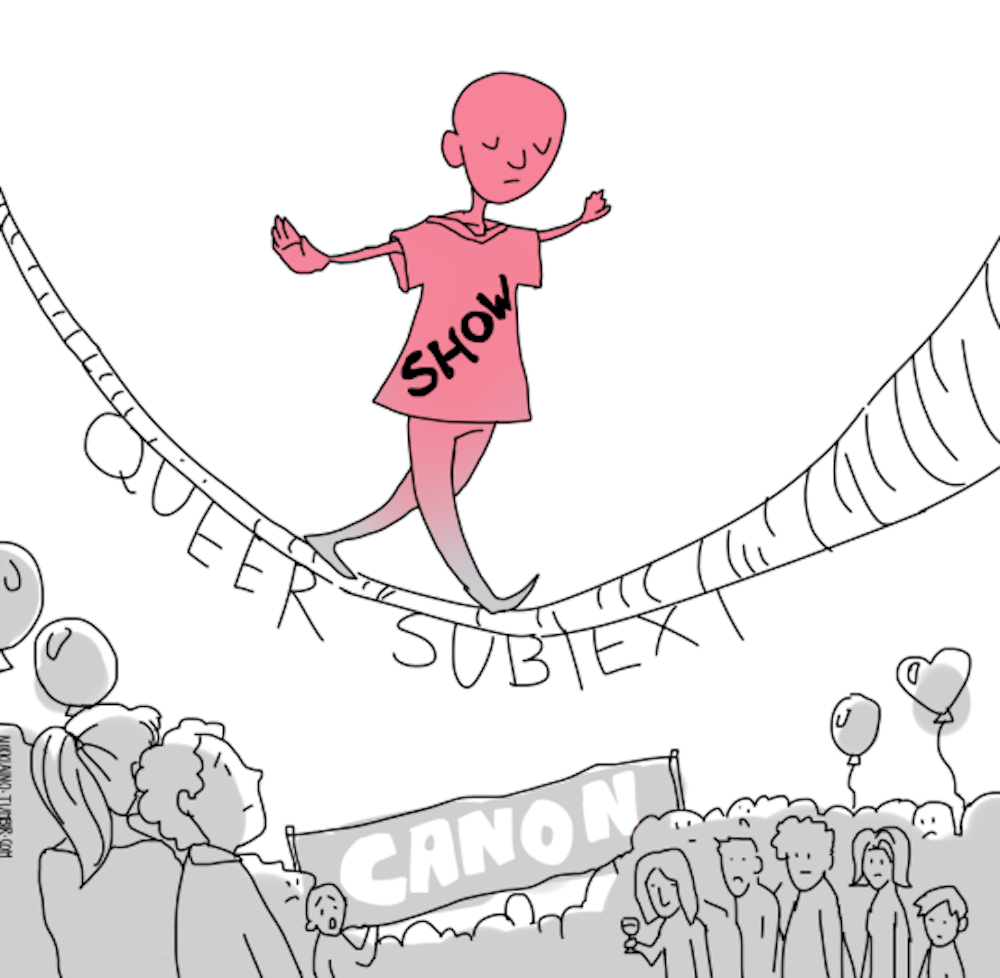
But, that bait is yanked back every time the producer is warned by their parent company to “dial down” the homosexuality in fear of losing their straight audience and being censored in homophobic countries. One of the more recent examples is Disney censoring the relationship between two male cops (confirmed to be gay by the creator Alex Hirsch) in Gravity Falls (2012-2016). Of course, this isn’t the only example of Disney’s censorship or a big company’s censorship in general, but it’s one of the most prominent because of Hirsch’s constant public complaints against the company for involuntarily queerbaiting its viewers.
Supernatural And Sherlock On Queerbaiting
When one looks up queerbaiting on Google, the first two searches include Supernatural (2005-2020) and Sherlock (2010-2017). Why is that? Because when people who were on early 2010s Tumblr think of the term queerbaiting, these two shows are the biggest offenders. “All or Nothing” is a very concrete example of Tumblr’s desperation for representation, but Sherlock and Supernatural showcase baiting that is borderline cruel. These shows coaxed out its fans’ desperation with queer subtext and characters only to quash any hopes of it and make the fans look dumb along the way. There are certainly examples of fans shipping two characters together because they’re both men or women and want to see them together, but Sherlock and Supernatural fans who ship Johnlock or Destiel do not fall into this category.
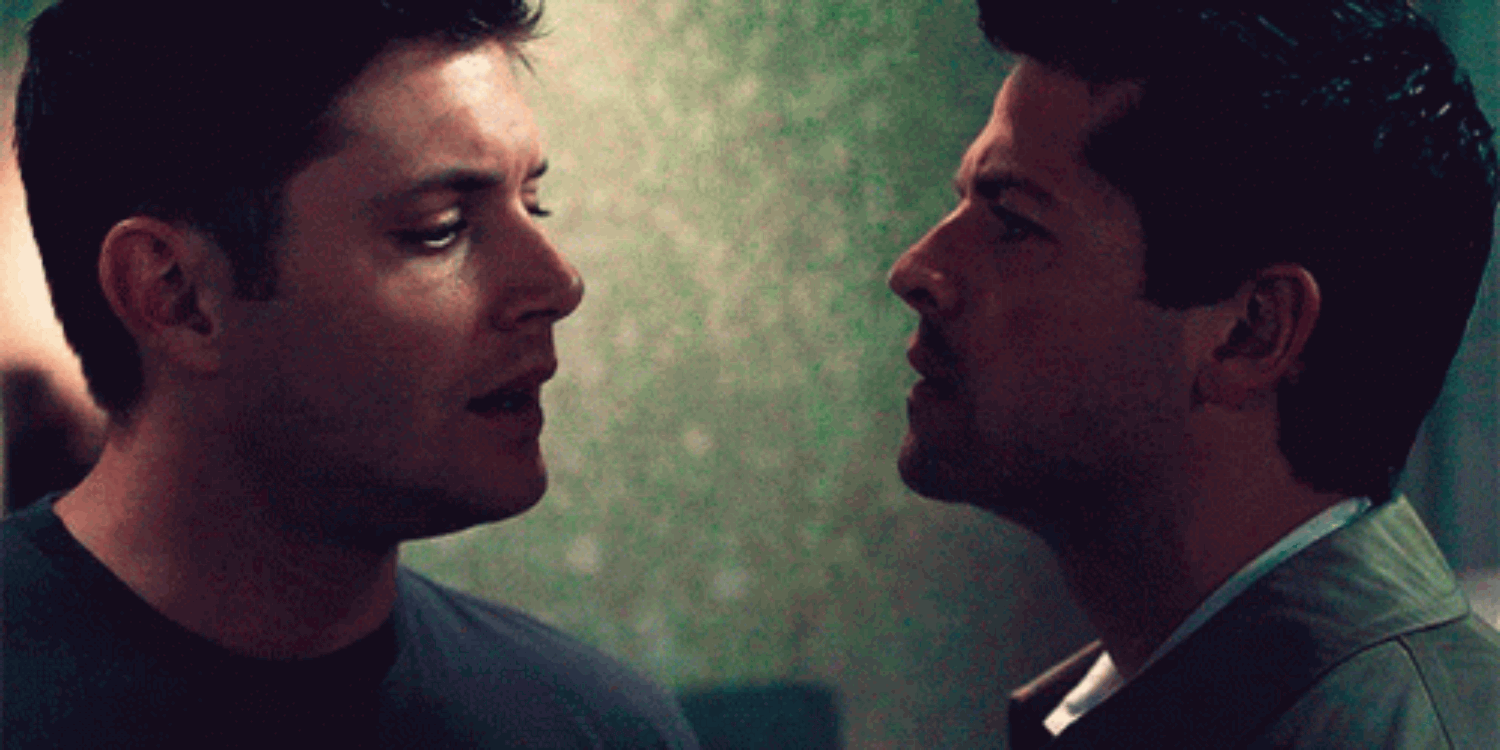
From the constant jokes about John and Sherlock being gay to Castiel and Dean’s longing gazes (that fans constantly turned into GIFs on Tumblr), it’s difficult to conclude these men are completely straight. If one-half of these pairs were women, there would be no doubt that they’re in love with each other. But because of the networks’ hesitations and the fact that these two shows have a large straight audience, both the producers and the networks don’t want the shows to end up being branded as a “gay show.” They don’t want to alienate their straight audience, so what do they do? They compromise at the expense of their queer fans’ identities and give them false hope with queer subtext that can be passed over by straight people but get queer fans excited about the possibility of their two favorite characters being like them.
These two fandoms, plus Doctor Who (2005-present), made up one of the biggest fandoms on Tumblr that joined into one conglomerate, dubbed “SuperWhoLock.” Hundreds of thousands of fans (if not millions) contributed thousands of hours to watching the show, promoting each episode, sharing to friends, dissecting and analyzing themes, and writing fanfiction and drawing fanart. Tumblr became one of the main hubs for free advertisement. People would attach Supernatural gifs to nearly anything, making the show ubiquitous enough for people who had never seen the show to know what the story was about and what Destiel was.
All of these shows profited immensely off their fandom, and even though this may be a bold claim, most of the shows’ main fans were people yearning for the representation they’d never get. They earned money, free advertising, and a consistent fanbase off queerbaiting their fans. Another bold claim: if the producers/writers had come out and definitively said that the characters weren’t gay and stopped with the gay subtext, they would’ve lost most of their audience and the hype around their show. So what do they do? Continue the subtext, continue the queerbaiting, knowing full well they’ll never deliver on it. They kill off queer main characters (as seen with Charlie on Supernatural, exemplifying the “bury your gays” trope), give queer characters small roles on the show, deny vehemently any homoerotic subtext, or a combination of all three.

However, the bold claim mentioned before is somewhat supported by statistics, as seen with Supernatural. We see a steady, if not drastic, decline in viewership and episode ratings throughout the years. While this is only up until season 10, we can assume the decline continues until the final season. There are many factors for this decline: show fatigue (seeing as there are more than 200 episodes), aging demographic (more passionate fans, being preteen girls, grow out of the fandom), and declining episode consistency and quality. However, one of the more drastic “bumps” in ratings is solely because of the lunch “date” between Castiel and Dean. Any episode with queer subtext or hints between Castiel and Dean receives a bump in both viewership and ratings, and those without subtext suffer.
As the seasons go on, queer audiences slowly fade away from the fandom due to its inability to make Destiel a thing while continuing the false hope. This all culminates into a horrible attempt at retribution in the penultimate episode of the final season, where Castiel confesses his feelings for Dean and then immediately dies. Unfortunately, this is often what happens in shows that queerbait. To give their queer audiences what they’ve been begging for for years, they save any “queer stuff” for the end so that they still have the straight audience and don’t get their show completely censored abroad, just that final episode. This is seen with Legend of Korra (2012-2014), where Korra and Asami share a tender moment at the very end, and in Adventure Time (2010-2018), where Marceline and Bubblegum also kiss at the very last episode.
It’s almost as if the shows are tossing a bone to expectant audiences, saying, “Here, now stop complaining; we gave you what you wanted.” But with Supernatural, it’s bittersweet, more bitter than sweet. After over ten years of developing a close relationship between the two characters, alluding multiple times to their feelings, audiences are given closure in the way of less than a five-minute confession, barely any response from Dean, and an immediate death afterward. While Supernatural isn’t the only show to use this trope, as shown with the previous examples, it sure is the most infamous one and one that had Tumblr in a chokehold for nearly two decades. Tumblr received no compensation for its passion for these shows except for a lackluster kiss or confession right at the end, and marginalized people deserve better.
Race-Blind Versus Race-Conscious Casting
This issue is beyond controversial and multi-faceted. Firstly, we need to define the difference between the two. Race-blind is when producers don’t consider the actor’s/character’s race and cast them randomly. Race-conscious casting is when producers make an informed choice to cast a certain character as that race, either because the plot deems race not pertinent or because their personality would bring more to the table.
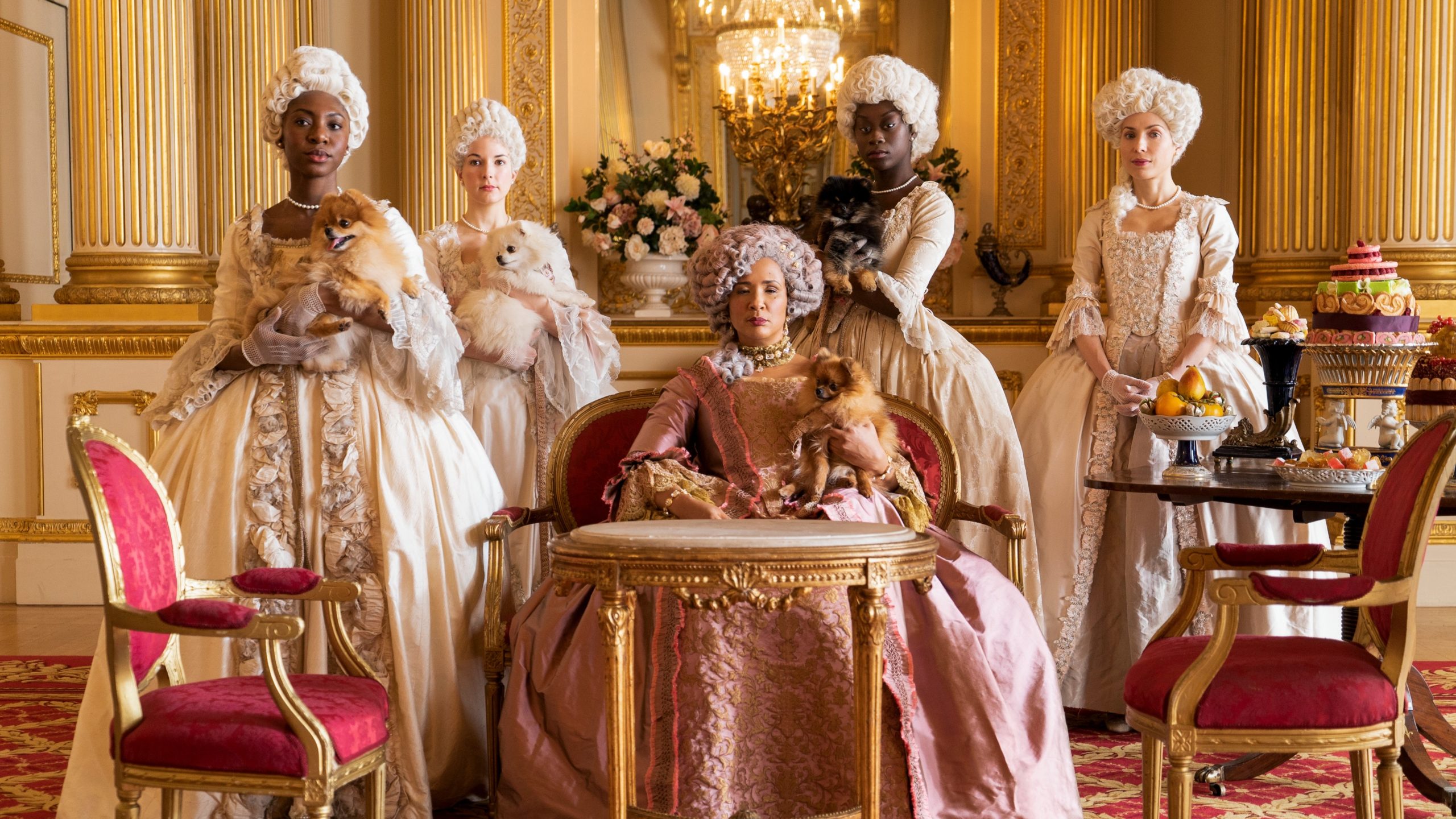
Race-conscious casting works because it casts people first while maintaining their identity and/or reimagining a society in which we are all equal from the beginning of history. Using Bridgerton (2020-present) as an example, it’s refreshing to see people of color in situations and contexts that used to be reserved only for white people, such as the Queen of England or as a handsome and powerful duke. It also doesn’t have to be casting people of color in traditionally meant roles for white people. Instead, it means casting people of color in a role that isn’t solely about their race, such as Civil War or drug/gang movies. Tumblr searches for this type of race-conscious casting because it treats people of color as, well, people while preserving their culture and identity and not making it the central part of the story as a sort of “trauma porn.”
Tumblr has a grand history of having diverse stories while not making it about shock value or profit. From fan art imagining book characters as people of color to people of color cosplaying, race isn’t involved on the website except when it’s explicitly called to be involved. Tumblr wants to see people of color portrayed as people, embracing their identities while also not having it be their only personality trait. They want to see themselves represented as faithfully and as realistically as they see all the time on Tumblr, but most shows fall flat.
The problem comes when it’s less race-conscious casting and more about race-blind casting, which comes off as trying too hard to please. They don’t give a second thought to what part they’re casting the actor in, so long as they’re casting somebody of color, which leads to controversial castings such as Anne Boleyn and the new Ariel movie with Halle Bailey. It’s interesting to see these previously white characters/historical figures portrayed as people of color, but people throw many criticisms at the actors and producers. Of course, most of these criticisms are racist, so they should be automatically ignored. But one criticism has value: we should be making more original stories that include people of color instead of casting them in remakes and live-actions that give no second thought to their identity.
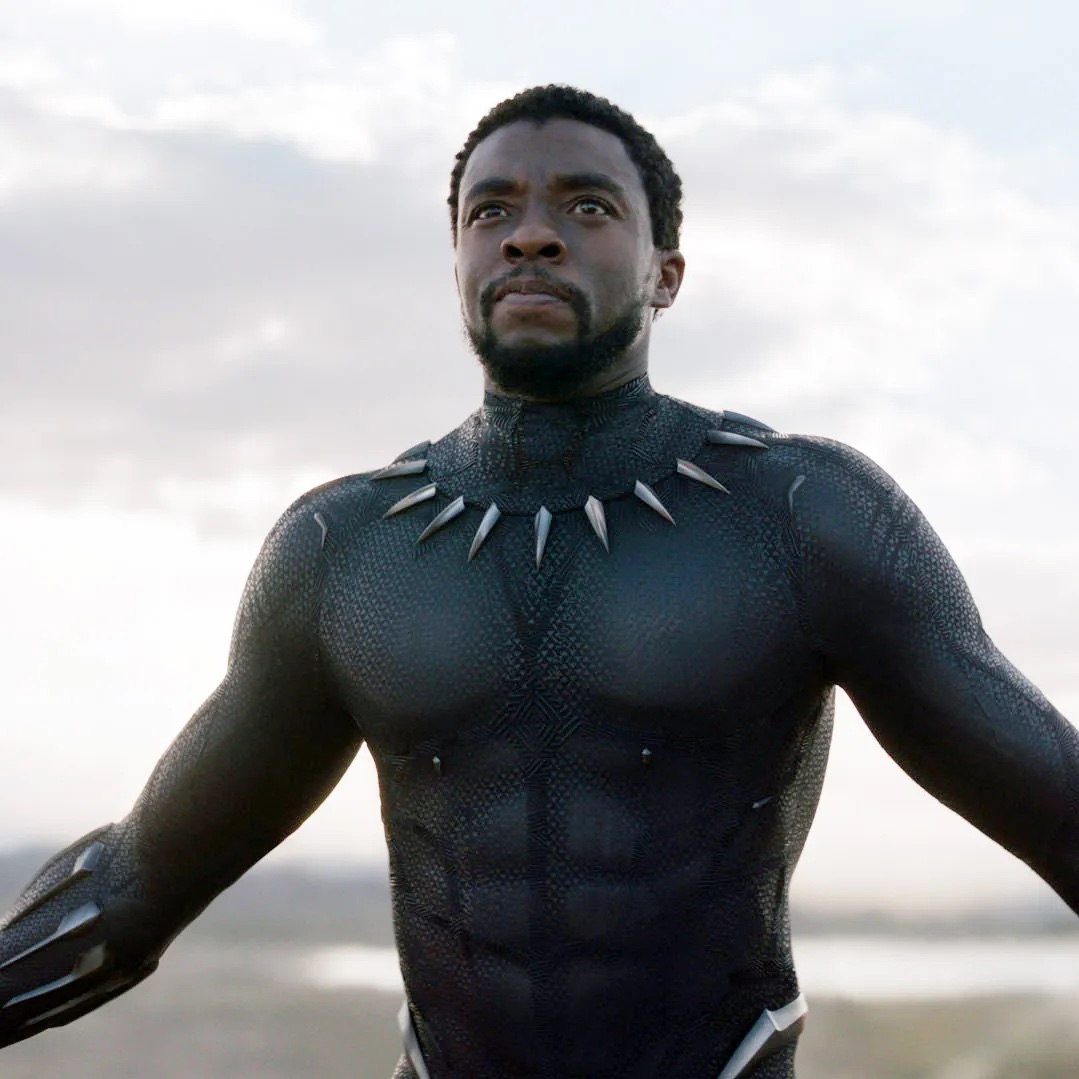
Tumblr creates new worlds for POC all the time, as evidenced by “All or Nothing.” It included two characters of color and many other fan arts, comics, and stories made on the site to make sure to include a diverse set of characters while managing not to try too hard and look like pandering. Tumblr users want to see their identities represented and give others a chance to see themselves represented, proposing hundreds of new ideas onto the site every week that could bring in lots of profits for big media companies. Yet these media companies continue to either cast white or light-skinned actors, fall back on racial stereotypes, or refuse to write and make a creative new show/movie starring a POC. So it makes sense that whenever a movie or show tastefully portrays POC, it gets a lot of attention and makes big bucks, such as Black Panther (2019) and Parasite (2019).
Will The Desperation Stop?
Short answer: no. Not unless big media companies learn a thing or two from Tumblr and actually begin to include POC and queer characters in their front lineup without queerbaiting or race-blind casting. It isn’t rocket science; write realistic, diverse characters. Marginalized audiences have been given false hope for years, wondering when they’ll see themselves portrayed tastefully onscreen. Tumblr’s desperation is not some cringey or annoying phenomenon brought on by whiny teenage girls who will throw money at anything that has a diverse plotline (as was the case with “All or Nothing”). It comes from a real place of yearning, of wanting to see themselves on mainstream media in the way that they see themselves on Tumblr all the time. It’s halfway through 2021, and mainstream media has yet to catch up with the diversity and compelling storylines Tumblr users have brought up since the early 2010s.
This desperation makes people do some things without thinking (such as supporting scams that promise diversity), but that shows how much money mainstream media would make if they give people what they want. Sure, it shouldn’t just be about money—it should be about supporting these communities while creating interesting new stories. But if there’s one thing we’ve seen from mainstream media, it’s that it’s motivated by money and ratings, and Tumblr is a goldmine for both. So the desperation will persist, and it’s up to Hollywood to turn that desperation into representation.
